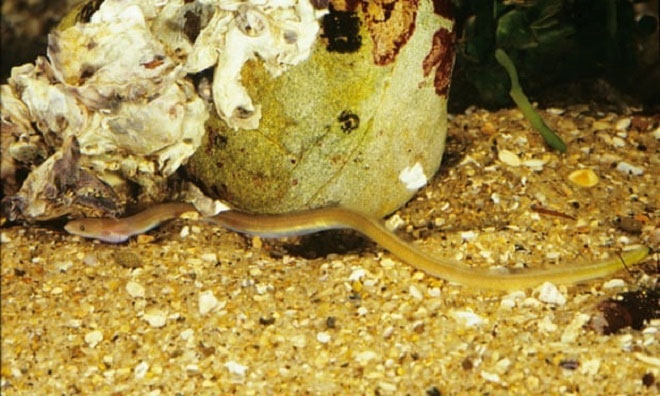Eels pierce the stomach of predators to flee
Despite being able to get out of the stomach, the snake eel still cannot escape the rib cage in the body of predators and eventually becomes a mummy.
The study, published May 27 in the Memoirs of the Queensland Museum, describes in detail the fate of some predators of the snake eel, but the prey pierces the stomach. However, after escaping from the stomach, the snake eel is still trapped inside the hunting animal's body.

Eel snakes mainly live under the soft sand in the sea floor. (Photo: Guardian).
Scientists from the Northern Territory Fisheries Agency, the Australian Fish Collection Project, the Queensland Museum, the Northern Territory Museum and Art Gallery, study the snake eel in Australia . The snake eel is an elongated fish that can swim quickly backward using the hard tail tip.
According to the research results, when swallowed alive, the snake eel tries to dig the way out. It is the tail with a hard tip that helps them puncture the stomach wall of a predator. However, they still could not escape and eventually became mummies in the hunting belly. Study co-author Jeff Johnson, a fisherman at the Queensland Museum, revealed that fishermen sometimes mistook snake eels for a giant parasitic worm.
The researchers found mummies of seven species of snake eel trapped inside 11 different species of predatory fish. These species are very diverse and live in many locations, proving that this phenomenon occurs on a large scale. Most likely predatory fish don't even notice the impact.
"The carnivorous fish can tolerate damage. Sometimes you will see the fish has a healing wound. Perhaps they are almost unaware of what happened," Johnson explained.
- Eel wolf - master predator on the bottom of the sea
- Chicks were born instinctively to avoid danger from predators
- Eels - Sex changing animals
- Video: Hundreds of eels rise and disappear under the seabed
- Eels are about to forget their faces, Japanese aquariums call guests for video calls
- Create the stomach in the world's first laboratory
- Eel bends like a hair at the bottom of the sea
- 4 taboo when eating eels is not everyone knows
- The 5 most mysterious mysteries in the animal world
- The eel waving off his head still bites the can of water
- Horror sea 'monsters' prey like alien animals
- Good diet for stomach sick people
 Surprised: Fish that live in the dark ocean still see colors
Surprised: Fish that live in the dark ocean still see colors Japan suddenly caught the creature that caused the earthquake in the legend
Japan suddenly caught the creature that caused the earthquake in the legend A series of gray whale carcasses washed ashore on California's coast
A series of gray whale carcasses washed ashore on California's coast Compare the size of shark species in the world
Compare the size of shark species in the world